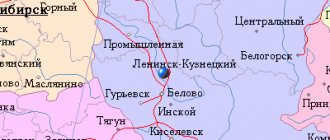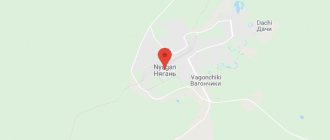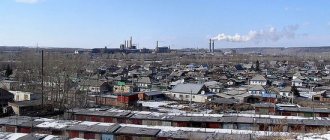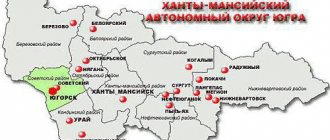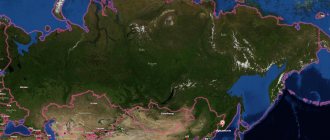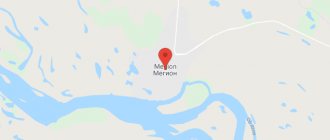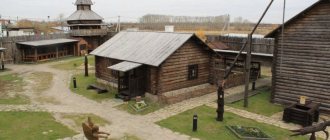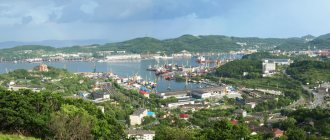Marked on the map of Russia, Leninsk-Kuznetsky is a city that grew up on the largest coal deposit. The first mention of it dates back to 1763. But in those days it was not yet a city.
The current Leninsk-Kuznetsky from 1763 to 1922 was called the village. Kolchugino (given in honor of a Russian settler), and in the period from 1922 to 1925 it was called the village of Lenino. Today, over 96,000 people live in the settlement, according to the population census at the beginning of 2021.
General information and history of the city
Leninsk-Kuznetsky is located in the west of Kuzbass (a natural geographical landmark is the center of the Kuznetsk Basin), about 100 kilometers south of Kemerovo.
The history of the city can be counted from the moment when coal outcrops were found near the village of Kolchugino (80s of the 19th century). Almost immediately, a working settlement was formed here, on the banks of the Inya River. However, before the revolution, little coal was mined, and only a few dozen people permanently lived in the mines. Serious development of the deposit began under the new government - in the 1920s. 1922 is the date of renaming Kolchugino to Lenino. And in 1925, the village of Lenino officially became a city. The name "Leninsk-Kuznetsky" was chosen to distinguish the new formation from several other "Lenins" that appeared in Russia in the first post-revolutionary years.
During the Soviet period, the city gradually grew, coal production grew steadily, and in 1989 the city of Polysayevo was separated from Leninsk.
See also[edit]
- Book of memory of miners of Kuzbass/Leninsk-Kuznetsky
| [ + ] Leninsk-Kuznetsky - a city of miners | |
| Perm region | Gremyachinsk • Gubakha • Kizel |
| Primorsky Krai | Partizansk • Artyom |
| Komi Republic | Vorkuta • Inta |
| Rostov region | Gukovo • Donetsk • Zverevo • Novoshakhtinsk • Shakhty |
| Tula region | Venev • Lipki • Nelidovo • Novomoskovsk • Uzlovaya |
| Chelyabinsk region | Bakal • Emanzhelinsk • Kopeisk • Korkino • Plast |
| Ghost towns | Kadykchan • Halmer-Yu |
Climate and ecology of Leninsk-Kuznetsky
In winter it is very cold in Leninsk, and in summer it can be unusually hot. Actually, the sharply continental climate that dominates the entire territory of Kuzbass makes all cities similar in this regard. If you have ever been to Kemerovo or Novokuznetsk, you know what to expect from Lenin weather.
The environmental situation is unfavorable. The Inya River, on which the city stands, has become significantly shallower over the past two decades, and fish stocks, once significant, are now minimal. This is primarily due to the development of coal deposits, accompanied by abundant industrial discharges into the river, water intake for technological needs, etc. Ecologists say that the bottom sediments of Ini are now largely technogenic in nature.
The mines have a negative impact on both the cleanliness of the air and the “general impression” of the surrounding space - in winter in Leninsk you see black snow too often. Boiler houses operating exclusively on coal also contribute.
Household waste dumps are probably the most minor problem. At the very least, city services are coping with garbage removal, and the landfill located in the industrial zone has not yet exhausted its resource.
Chapel "Joy of All Who Sorrow"
A small marble chapel with a gilded dome became a decoration of the city center. It was installed in memory of the murdered miners.
The first prayer was performed in 1999 by Archbishop Sophrony. This event was observed by the widows of miners with children and about two thousand townspeople.
The book, specially prepared for this event, is biographical in nature. About 1,500 destinies of miners were described in this book, their lives lived and pain at the Kuzbass mine.
Location: Kirova Avenue - 37a.
Population of Leninsk-Kuznetsky
The city's population is steadily declining. The increase was observed until perestroika (the historical maximum was more than 165 thousand inhabitants in 1989). At the same time, Polysayevo was separated into a separate city - the sharp decline in 1989 was associated precisely with this and can not be taken into account in assessing the situation.
Lenin Avenue
But from 1992 to the present day, the number of Leninsk-Kuznek residents has fallen by more than 20 thousand people (now just over 99 thousand people) - a serious indicator for such a small city.
The unfavorable economic situation in the 90s, traces of which can easily be found now, difficulties with raising children (it is difficult to get a good education in Leninsk itself), and the lack of prospects for young people are the main reasons for the migration of city residents to the relatively prosperous Tomsk and Kemerovo.
The mortality rate is high, and the birth rate increased slightly even in the “well-fed 2000s”. Let's look at the statistics again. In 2001, 20 thousand children studied in thirty-five schools in the city. Already in 2005, there were 26 schools, and fewer than 12 thousand students. Talking facts.
Almost half of the residents are people of retirement age, more women (miners, as a rule, do not live to old age). The demographic situation is aggravated by widespread drunkenness. Vodka is popular among older people, beer among the younger generation. Perhaps the main problem is that a person’s environment from the first years of life contributes to the development of bad habits - the traditions of “gop culture” are strong in Leninsk.
Actually, the most common types in the city are the “gopnik”, the hard worker (this type is often combined with the first), and the pensioner. There is a thin layer of “informal youth” - Rastafarians, fans of alternative music, rockers, and a slightly less thin layer of intelligentsia (mainly teachers).
“You shouldn’t be looking for miners here, they all died a long time ago.”
In the conversations of Kemerovo residents, one can sense resentment: “Moscow remembers us only when something happens.” They do not hide their prejudice towards Muscovites - Moscow is only interested in the natural resources of Kuzbass, profit, and does not care about people’s problems.
Mikhail Fedyaev, president of the Siberian Business Union holding, which owns Listvyazhnaya, is also considered here as an envoy of the federal center. Although he is just local: he was born in Prokopyevsk, graduated from Kuzbass Polytechnic. Must be able to speak the same language with miners.
Kemerovo, with its population of half a million, is outwardly harsh. The lion's share of the housing stock consists of dull panels. There are also more architecturally intricate brick buildings from the 1930s to 1950s. However, many of them are dilapidated buildings with crumbling plaster.
Stands at the military registration and enlistment office on Lenin Avenue offer to join the army or navy under a contract. Such a service is “considered prestigious and attractive by many young people,” the text reads.
“Ha, we found something to photograph,” a passerby reacts. It seems he doesn't believe the propaganda at all.
On the streets of Kemerovo
Photo: Vil Ravilov
The godfather of Kemerovo is considered to be Mikhailo Volkov, who exactly 300 years ago, in 1721, was the first to discover coal deposits on the banks of the Tom River. From this date the official history of Kuzbass is now being conducted. He is the same age as the Russian Empire.
Data on Volkov’s appearance has not been preserved. However, his collective image was cast in the monument. Mikhailo’s image adorns chocolate wrappers at the airport. The price is steep - 395 rubles per tile. Typically, souvenirs in the spirit of “Greetings from Kemerovo!” made in Novosibirsk or Tomsk. “There is no work except the mines” - these words are confirmed in small things.
There is only one taxi fleet left in the whole of Kemerovo, owned by a local entrepreneur. The rest were taken over by people from neighboring regions, the taxi drivers themselves say.
Kemerovo does not seem to exist for Russia - ask the average Russian what the city is associated with, and the first thing he will remember is the monstrous fire in the Winter Cherry shopping center. There, on March 25, 2021, 37 children and 23 adults died. The Park of Angels is now located on the site of the burned shopping center. This is an unhealed wound on the body of the entire Kuzbass.
The place where the Winter Cherry shopping center was located
Photo: Vil Ravilov
Now another such wound has appeared. You can find spontaneous memorials in memory of the Listvyazhnaya miners in various parts of the region from Kemerovo to Gramotein.
Many of the dead lived in Belovo.
“Go to the MZHK house,” they suggest in this city. “Only miners live there.”
The Komsomol program MZHK (youth residential complex) existed in the Soviet Union from 1971 until the disappearance of the Komsomol in 1991. Future residents took an active part in the construction of the house and received an apartment as a reward for their efforts. The Komsomol is long gone, and former activists have turned into Russian pensioners. The history of the house is reminiscent of the giant letters “MZHK” lined with red bricks at the end of the building.
“You’re in vain looking for miners here, they all died a long time ago,” the first local resident he met was dumbfounded. As it will soon become clear, he somewhat embellished the reality. But the leitmotif is this: men die before they reach 65, the authorities do not care about the population, and the mines continue to explode.
“Petrov was 31 years old. “There are three children left,” says the woman who came out of the entrance. “I knew Sashka well, he grew up before our eyes. He was an electrician and wanted to earn money. But what happened... It’s very, very sad. There are simply no words."
Belovo does not give the impression of a depressive town. The streets are quite clean, there are decent foreign cars in the courtyards, and shops are literally on every corner. Although the statistics are merciless: the population decline over the past 10 years has amounted to almost 10 thousand people. There are fewer residents of Belov every year. Compared to the late 1980s, the population has halved.
Across the road from the MZHK building, right between two five-story buildings, there is a patriotic park “Victory”. Red-cheeked children are tumbling in the snowdrifts next to a Katyusha and a real T-55 - it was the world's first tank with an automatic anti-nuclear defense system. In fact, they say that local authorities wanted to supply the T-34. But the legendary combat vehicle is now in great short supply, so the Belovites had to be content with a tank of post-war production.
Pobeda Park in Belovo
Photo: Vil Ravilov
Every passerby in Belovo turns out to be a miner. They flatly refuse to speak into a tape recorder, but they agree to an informal conversation.
A man in his late 60s with clear, expressive eyes looks at first with disbelief. But this long-experienced miner cannot remain silent about Listvyazhnaya either. The conversation begins, he says that the professionalism of ordinary workers has increased significantly. The men no longer smoke in the slaughterhouse as before, they try to follow the rules and do not risk their lives in vain.
But there is one phrase that any interlocutor will repeat like a mantra: “We need to increase production!” — with emphasis on the “O” in “prey.” This mantra is repeated to miners by their bosses. Having heard it a thousand times, it is the first word that comes out of the lips of everyone who is even more or less familiar with the mining business. To fulfill the plan, the men work in the mine with dangerous concentrations of methane - management will not wait until the indicators return to normal.
At the scene of the disaster in Listvyazhnaya, November 28, 2021
Photo: Anatoly Kuzyarin / TASS
Districts and real estate of Leninsk-Kuznetsky
Officially, the city is not divided into large areas; the map of Leninsk is a set of residential microdistricts (they are concentrated in the northeastern part of the city), and “near-mine” villages.
3 microdistrict
Plus the city center, which most closely resembles a civilized city. In the north there is an industrial zone. However, this does not mean that there are no mines in other parts of the city; only the northeast (well, and the so-called center) is considered “coal-free”.
The unofficial geography partially follows the official one, but the most odious areas of the city, of course, have popular nicknames. First of all, it is worth noting the areas that, from the point of view of an ordinary person, are unsuitable for life - the crime rate, which is already extremely high in Leninsk, is considered simply off the charts here. And if this fact is not particularly noted in the Internal Affairs Directorate reports, it is only because “strangers try not to come here,” therefore, the number of statements is much lower than the real number of offenses. After all, it is not customary to write statements about “squeezed cell phones” in your area - in a police environment, an informer is automatically transferred to the most despised “subclass” of people – “reds” (however, more about crime in the corresponding section).
So, the three most disadvantaged areas of the city:
- the Central Market area (markets in residential parts of the city in general often become habitats for various kinds of marginalized people, Leninsk is no exception);
- “Seven” (village of the “Seventh of November” mine);
Seven
- “Tenth Precinct” (ironically, the city mental hospital is located here; some Leninsk-Kuznek residents believe that the space inside and around the hospital fence does not differ much in terms of the level of development of the population).
Tenth precinct
However, each resident of Leninsk will make his own “top” of the most terrible places - there is no shortage of areas in the city that meet the criteria. The only advantage of moving to these areas is fairly cheap housing (a private house connected to a water supply can be purchased for an amount not exceeding 500 thousand rubles). A one-room apartment will cost a little more – up to 700 thousand. At the same time, many good people live here, but this is rather due to the inability to leave and the force of habit. And yes, houses like the ones in the photo below are very rare.
In general, cheap houses are on sale in all villages within the city, be it “Komsomolets”, “November 7th” or “Dachny”, but living in them is associated with certain difficulties. In addition to the high crime rate, widespread drunkenness of residents, bad roads, there is also a lack of infrastructure necessary for civilized life - you can forget about hot water from the tap, there is no access to the sewerage system.
The geographical and unofficially recognized center of the city coincide - it is a conventional area around the only entertainment center. Registry office, administrative buildings, good shops, cafes. If you are moving to Leninsk, then it is worth living here or in microdistricts in the northeast - fortunately, new residential buildings are being built.
Apartments in both places are expensive by Lenin’s standards: a one-room apartment can be bought for 800-900 thousand, a two-room apartment for two hundred million, a three-room apartment for one and a half million. At the same time, interesting offers sometimes appear on the secondary market - apartments in less than perfect condition for a price 10-20 percent lower than the market average. As a rule, such purchases are justified - repairs in Leninsk will not bring large expenses (workers value themselves much cheaper than is customary in large cities).
Museum of Local Lore
The museum was founded in 1934 and is a historical treasure of the city. Here there is a unique opportunity to visually learn about historical events. The main reason for its occurrence is the extensive accumulation of historical monuments and antiques. Having authentic collections of events from past years, the museum is of particular value. The exhibition is dedicated to the city’s participation in the Second World War and is shown in the local history museum in the format of chronicles and rare volumes.
Location: Kirov Avenue - 51.
City infrastructure
Roads in Leninsk have at least some kind of marketable appearance only in the center and in residential areas. In some places (especially in villages within the city) the road network is in poor condition. At the same time, in some places in the center the asphalt is laid simply perfectly - one of the sad paradoxes of the city.
On the positive side: there are no traffic jams here. Which is not surprising, given the size of Leninsk.
Housing and communal services tariffs, as elsewhere in Russia, are growing rapidly. For example, in 2011, some categories (sewage, hot water supply) grew by 20%. Situation in autumn 2012:
- heating - 21.02 rubles per square meter of area (taking into account the standard of payment), or 32.34 rubles per square meter (in the amount of 100%);
- hot water – 76.77 rub. per cubic meter (“Vodokanal”) or 49 rubles per cubic meter (FGLPU “NKTsOZSH”);
- cold water – 18.49 rub. per cubic meter;
- water disposal - 12.86 rubles. per cubic meter;
- electricity – 1.62 rubles. per kWh or 2.31 rub. per kWh (if a stationary stove is installed in the house/apartment).
The provision of transport is acceptable - not only buses, but also trolleybuses run in Leninsk. You can get to Kemerovo or Tomsk either by intercity bus or by train.
There are relatively few problems with kindergartens in the city. Despite the fact that nine kindergartens have closed since the beginning of the 2000s, more than half of the children of the corresponding age attend the remaining thirty preschool education institutions. The problem of lack of places is mitigated by the fact that a significant part of the city’s female population are housewives.
There is no shortage of secondary schools, but parents with slightly above-standard education have limited choice: only two gymnasiums and one lyceum.
Future athletes are trained at the children's and youth sports school, and gymnasts/gymnasts at the Mametyev Sports and Youth Sports School. The city also has a music school, a palace of creativity, a house of technical creativity and a center for further education. The people working there really do everything that can be done in such conditions, but this does not save the situation as a whole - it is very difficult to provide a well-rounded education for a child in the city.
***
Mining foreman of the fifth section Gennady Beloshkursky was considered one of the most experienced miners. He is a representative of a real mining dynasty, of which there are many in Kuzbass. His father, father-in-law and brother worked in the mines. Beloshkursky’s son also continued the family business.
Gennady came to Listvyazhnaya back in 2011, having by then replaced several mines, including Raspadskaya, where 91 Kemerovo miners died in 2010. Actually, he would like to work closer to Prokopyevsk, where his home was, but almost all the mines near Prokopyevsk closed. There were no options left: we had to move to Belovo.
Friends and colleagues loved Beloshkursky for his cheerful disposition and desire to help anyone. According to daughter Ksenia, her father never refused anyone: “Genka, take me!”, “Gena, help!” He did not let us get discouraged and did not get lost in critical situations. The 48-year-old specialist truly loved his job and tried to pass on his thirty years of experience to his younger colleagues.
Gennady Beloshkursky with his wife
Photo: from the family archive
In 2021, Beloshkursky was on the verge of death - he was overwhelmed by rock at Listvyazhnaya. But, as Ksenia says, they hastened to hush up the scandal. After the hospital, Gennady returned home, rested and went down to the face again.
Looks like they knew how to hush it up at Listvyazhnaya. Only after the death of 51 people began to talk out loud about two fires one after another in November 2021 - they were extinguished by the miners themselves. The miners knew that the methane concentration level there was close to critical. But the management did not stop work. As the workers themselves, with whom Lenta.ru managed to talk, now claim, they were only told: “If there is no coal, you will not get anything.”
One day Beloshkursky mentioned at home that he might be fired. He argued with his superiors, at one point directly stating that it was impossible to work in the mine.
On November 25, Gennady went on his first shift after sick leave. During her illness, she and her daughter made plans for the future, joked and laughed to cheer themselves up.
I think my dad is a hero. Usually, during emergencies, people begin to think about themselves and flee the sinking ship. My dad didn't do that
Alexander Petrov, one of the miners whom Beloshkursky tried to save, also died. Now Ksenia is wondering why the rescue operation was carried out so strangely: the search for the miners was quickly curtailed, although there could be living people in different places of the mine. She is sure that the relatives of the miners were not told the whole truth.
“In my opinion, they don't need witnesses. If those who were already considered dead had come out, the mine would have been closed. The bosses would stop receiving money. The miners who knew the mine suggested to [Governor Sergei] Tsivilev: “If you can’t, give us the equipment, and we’ll go down there ourselves.” He refused without giving any reasoning. The message is: “We need to save the mine so that it doesn’t collapse.” The governor was asked the question: “What will happen to the people who are there?” He said abruptly: “They haven’t had oxygen for a long time,” says Lenta.ru’s interlocutor.
Beloshkursky’s family would never have known anything about the circumstances of the miner’s death if they had not obtained his mobile phone: it was lying in the changing room, because miners are forbidden to take gadgets with them into the mine. The miners' correspondence in the messenger contained all the details about the moment when the explosion occurred.
They read how Gennady led several people outside and definitely could have saved himself, but decided to go after others.
As the new acting has already announced. the director of the mine, the miners will gradually be called to Listvyazhnaya, two or three people at a time. Like many others, Ksenia is scared to imagine that her brother will go underground again - especially since he worked at the fourth site, where the explosion occurred. But the girl just shrugs: “There’s nowhere to go. We have nowhere to work except the mines.”
Pipes of Kuzbass
Photo: Vil Ravilov
Enterprises and work in Leninsk-Kuznetsky
The city's economy is, of course, based on coal mining. Mine named after Kirov, mine named after. November 7, mine named after. Yaroslavsky, “Komsomolets”, “Kolchuginskoe”. The life of miners here is no more fun than in other cities (in Kuzbass, there are really “stupid” salaries only at Raspadskaya in Mezhdurechensk). A monthly salary of 20 thousand rubles or more is the prerogative of miners working in the face; other mine workers receive less.
Kuzbasselement produces batteries - at this plant you can earn up to 15 thousand a month. If, of course, they can be obtained at all. In 2009, the owners of the enterprise disappeared, leaving unprofitable production and wage debts - now the situation has normalized a little, but it is clearly too early to add Kuzbasselement to the white list.
Women can get jobs as workers at a worsted cloth factory (salaries are symbolic - up to 10 thousand) or go to the service staff (sales consultants and waitresses in some places earn more) - to Travelers or the Chamber. However, good vacancies in the service sector appear extremely rarely.
Shopping center Fabrika
Insufficient infrastructure development makes the city attractive for entrepreneurs. A person who opens, for example, an interestingly designed and inexpensive cafe in a residential area in the northeast can count on a good profit. Another thing is that fighting constant checks, the greed of officials, and crime is a matter for strong-willed people. But for people associated with local authorities, only good luck awaits them in business - amazingly lucky ones (I note that this paragraph consists mainly of guesswork - in no way do I want to offend the officials of this glorious city).
The city's doors are open for representatives of well-known networks. But if you do not own Apricot or, say, Euroset, you need to think very carefully about the prospect of starting a business in Leninsk. Especially considering the information in the next section.
“We’re suffocating, we can’t do it anymore”
Mining labor is estimated at an average of 60 thousand rubles per person. Retirement is possible either upon reaching 25 years of total experience, or after 20 years of continuous work in the face. In the old days, everyone was entitled to a trip to a sanatorium once a year. Today, travel tickets are given only for medical reasons. Employees receive corporate SIM cards at a favorable rate and free coal to light the stove. There are no other benefits. But large families are provided with an additional payment - something like seven thousand.
“The work can be different, you can shovel for one day, dig for the whole shift, eight hours, without giving up,” Nikolai Alimov, a miner from Listvyazhnaya, explained to Lenta.ru. — On the second day there may be a different task, physically easier. And the conditions are different. For example, the roof of a mine after destruction may stand normally, or it may collapse immediately - this is dangerous, stones will fall. There is a layer that shoots out in pieces, and that’s also not good enough. And you can even carry 20 meters, or you can carry 100.”
Some work until they are 50 and retire. Some people reach 60. Everyone's health is different. There are no special prospects outside the mines - in almost any field, a miner will face a threefold reduction in wages.
“Few people get pleasure from physical work; it’s hard work. I get pleasure from tinkering with spare parts and repairing computers - it’s a hobby, it’s interesting to me. But you just go to the mine to earn money,” states Alimov.
At the Listvyazhnaya mine
Photo: Vil Ravilov
The nearest settlement to the Listvyazhnaya mine is Gramoteino. This is a typical village of coal mining Kuzbass. A village with this name was formed back in 1727 on the Inya River, where fish could be caught by hand. All around is impassable taiga with wild animals. According to legend, among the dark population, who could not read and write, a certain literate suddenly appeared - on behalf of the people, he wrote letters to the authorities with complaints and thanks. History has not preserved the name of this man, but immortalized it in the name of the village.
“Listvyazhnaya” was once called the same. Over decades of continuous work, it has experienced many incidents. The 2004 accident killed 13 people. Old-timers also remember the fire that broke out on July 12, 2015 due to the operation of a compressor unit with faulty safety equipment. By the time rescuers arrived, the open fire had then spread to the entire section of the mine, and the gas situation had reached an explosive concentration. People's eyes were eaten away. It was possible to eliminate the accident. At the same time, three mining faces with expensive equipment had to be mothballed.
Photo: Vil Ravilov
Recently, Grammar eleventh graders went to courses to choose a profession. Most boys want to continue the work of their fathers and grandfathers and go to the mine. For them, the Listvyazhnaya explosion is something that happened to them personally. It is a rare citizen who does not have relatives or acquaintances among the victims of the disaster. Three students from a local school were left orphans. Inna Piyalkina, the widow of 55-year-old miner Boris Piyalkina, who has often spoken in the media in recent days, teaches chemistry here.
The village only talks about the explosion,” her colleague, teacher Irina Dmitrievna (name changed), tells Lenta.ru. — The methane concentration in the mine was 7.1-8 percent. Seryozhka (name changed), a neighbor, said: “We’re suffocating, we can’t do it anymore.” Yes, all our men were wailing: “Oh, it’s going to explode!” But we still went there. Management knew about the eight percent methane and made them work. The production deputy only urged: “Come on, guys, I’m with you!” And at six in the morning he left the mine for home. Having learned about the tragedy, I immediately called Seryozhka’s wife. “Alive,” she said. “It’s his day off.”
Locals claim that a representative once said: I would rather pay a million for each person killed than stop the mine. Whether this is actually true is impossible to know.
As Natalya, a grocery store saleswoman, admitted, every time her husband went to work on his shift, she almost began to pound: “Yes, everyone knew about the gas”; “Yes, the authorities demanded loot.”
Buyers nod their heads. “They are ruining our men,” says one of the women.
Teacher Irina Dmitrievna says that at Listvyazhnaya everyone relied only on chance. They preferred not to think about the consequences. In 2004, an accident occurred because someone decided to smoke. Now this is simply impossible - men have become smarter.
“When the mines were state property, there were few large-scale accidents, only isolated cases: someone gets hit with a stone, another gets caught under the tape,” she says. - But private owners came... Repairs have not been done at Listvyazhnaya for a long time. We need to change the ventilation, and we can work. The work is normal."
Drilling wells in the areas of the supposed epicenter of the explosion at the Listvyazhnaya mine
Photo: Press service of the Kuzbass government administration / TASS
Crime
We can talk about crime in Leninsk-Kuznetsky for a long time. An indicative point: the area of Victory Square (this is the city center, the registry office is located nearby) in police reports is equated in terms of crime level to the depressive area of the Zakamyshan hospital. In practice, this means that you can be robbed anywhere: even if you are walking along the main street in the evening, it is reckless to feel safe.
Situations are still possible in the city that residents of many regions have already forgotten about. The seizure of Ursa Bank in 2009 caused a wide resonance. A man armed with a firearm took five people hostage. He demanded the release of his friend from prison, a round sum of money and a plane. It is noteworthy that the governor himself went to negotiate with the invader, but everything ended according to a harsh scenario: riot police killed the criminal during the seizure of the building. The hostages were not injured.
However, some cases are of interest not because of the scale of their villainous acts, but because of their almost cartoonish comedy. In the summer of 2012, a healer was detained in Leninsk for “treating” clients by taking gold and jewelry from them (allegedly in order to sanctify them). The jewelry ended up in a pawn shop. And the would-be healer (a drug addict, by the way) received three “suspended” years in prison.
It is somehow not customary to remember the era of the 90s in Leninsk. Probably because the criminal component of city life has changed little. In Leninsk, random interlocutors, as of old, talk about how “half of the city is held” by K***. And they remember that some time ago another authority was widely known (with a surname also beginning with K), but after the “showdown” that ended sadly for him, he left for Novokuznetsk. Yes, they don’t shoot in the streets like in the 90s. But in fact, little has changed. First of all, the thinking of the townspeople has not changed.
St. Seraphim-Pokrovsky Monastery
The city's stone church with beautiful architecture today is associated with a convent. The history of this monastery begins in 1852. After a series of reconstructions, it was decided to build a new church. The basis for the construction was the formation of a convent. The 1987 decree documented and registered the Orthodox community at the Intercession Church. The opening took place in April 1992.
Location: Sovetskaya street - 187.
Entertainment complex "Pobeda"
The cultural and entertainment life of society includes cinema, billiards and other entertainment. The first place for leisure is considered to be the Pobeda cinema. Built in 1938 this cinema was completely renovated in 2001.
Today this establishment has the status of an entertainment center. Having an excellent location in the central part of the city, Entertainment is very popular among citizens.
The complex includes not only a cinema with a cinema hall with 225 seats, but also a billiard room with bowling alley and a cafe.
Location: Kirova Avenue - 34.
Memorial to fallen heroes during the Great Patriotic War
The memorial monument has a unique structure, consisting of three separate parts. On the one hand, the memorial has an Eternal Flame and a weapon in the form of a cannon. Nearby there is a stone Order of the Second World War. In conclusion there is a bust of A.P. Shilin.
This building is an eternal memory of those who died for the sake of victory. Thousands of soldiers went to fight and never returned. The main historical monument is installed on Victory Square with the words: “For valor in battles, for feats in labor - the townspeople are grateful to their fellow countrymen.”
Monuments to fallen heroes are located near the mines and are immortalized with memorial plaques, and the streets are named after fallen miners.
Square of heroes of the Kolchugin uprising
The event of 1919 turned Soviet history upside down, playing a significant role in the imbalance of Kolchak’s rear and the establishment of Soviet power.
The monument was erected in 1957. The event of April 1919 claimed the lives of hundreds of miners. 600 people were shot here.
This is a kind of mass grave. On the front side of the obelisk there is an inscription: “To the Heroes of the March Uprising.”
Some changes and additions were installed in 1985. This memorial is protected because entered into the Unified State Register of Cultural Heritage of National Significance.
Monument to twice Hero of the Soviet Union A.P. Shilina
This monument is dedicated to the events of the Second World War and was erected in 1953. This monument was erected in honor of the twice awarded hero A.P. Shilin.
Afanasy Petrovich was an honored Hero of his time. His exploits made an enormous contribution to the victory of the Russian people over fascism. We must remember this and give thanks for the peaceful sky above our heads. Walking near the bust of memory of them. Shilov, remind us of the heroism and unbroken character of Russian soldiers.
Alley of Miners' Glory
This very interesting and memorable place became the property of the city in 2002 on Miner's Day. The common people call it more simply - miners' alley. Several memorable dates were dedicated to the opening day. This is the fiftieth anniversary of the miner's day, the sixtieth anniversary of the formation of the region and more than a hundred years since the founding of the mine itself.
Interesting sculptures in the form of trolleys commemorate the mining town. The stele - a pile driver, in the center of the memorial, symbolizes the hard work of the miners. The restoration of the alley took place in 2008, adding and updating its appearance. The stela-koper characterizes the 125th anniversary of the mine and the production of the billionth ton of coal.
